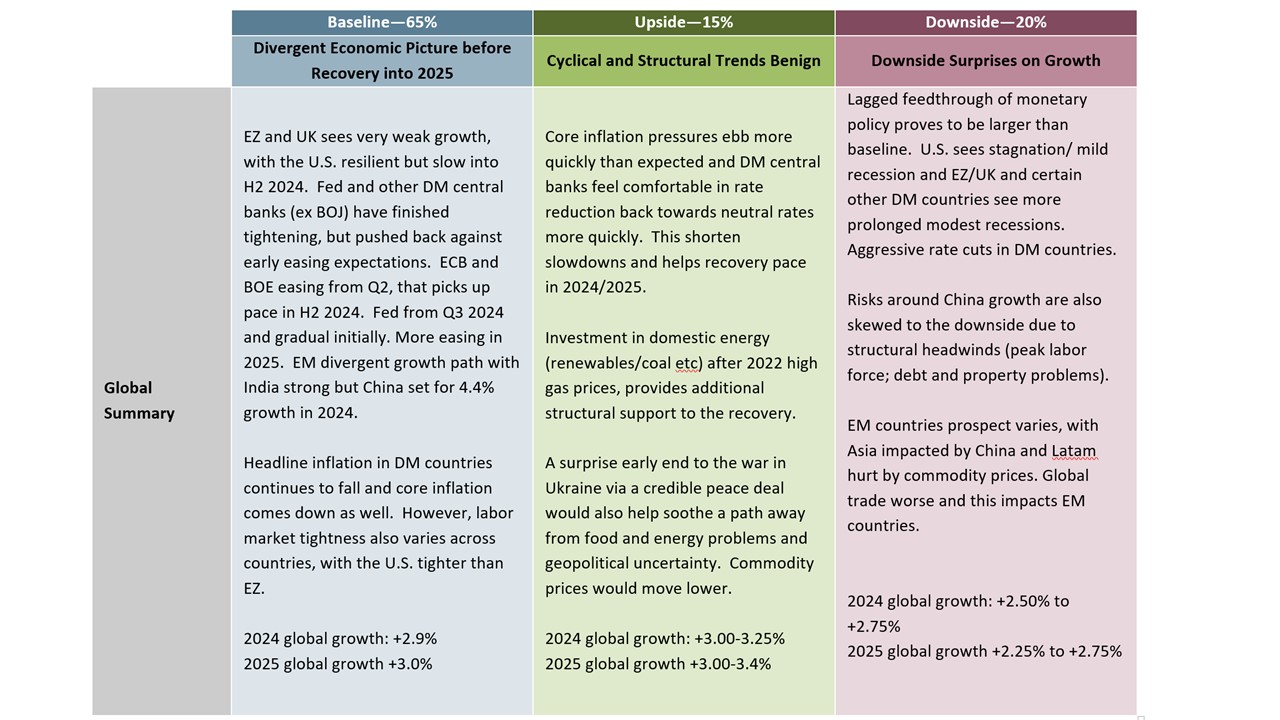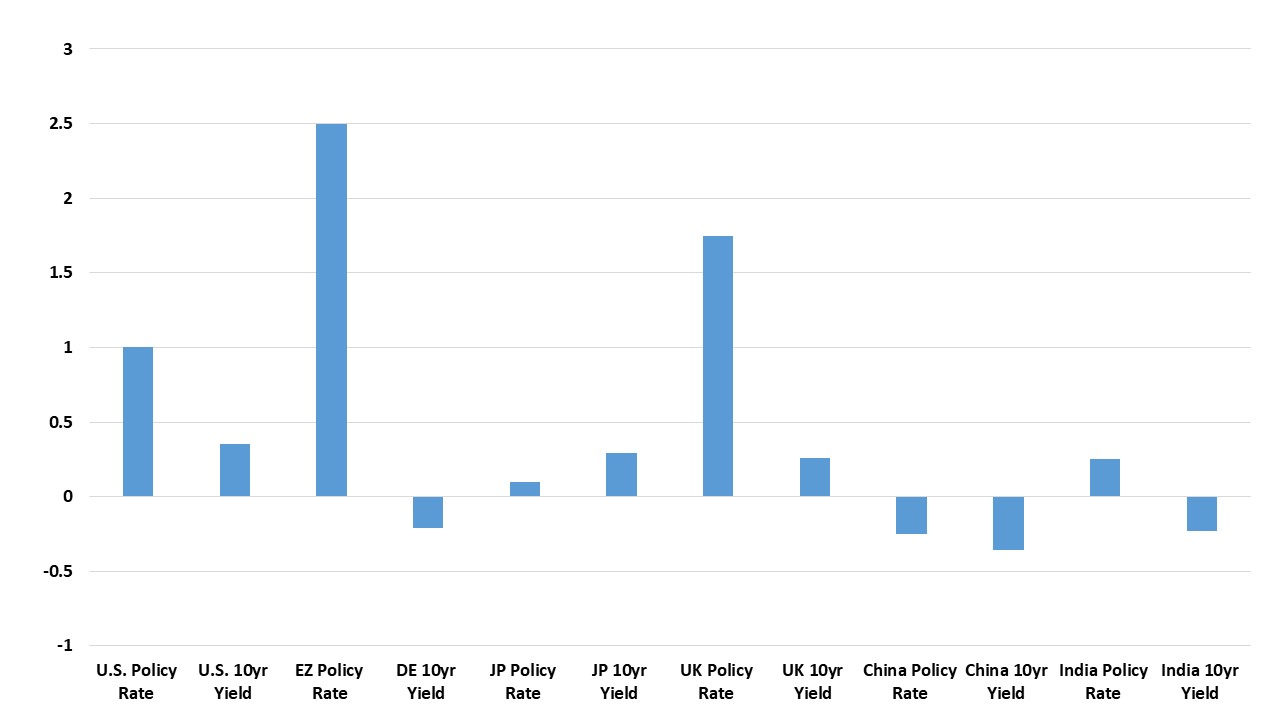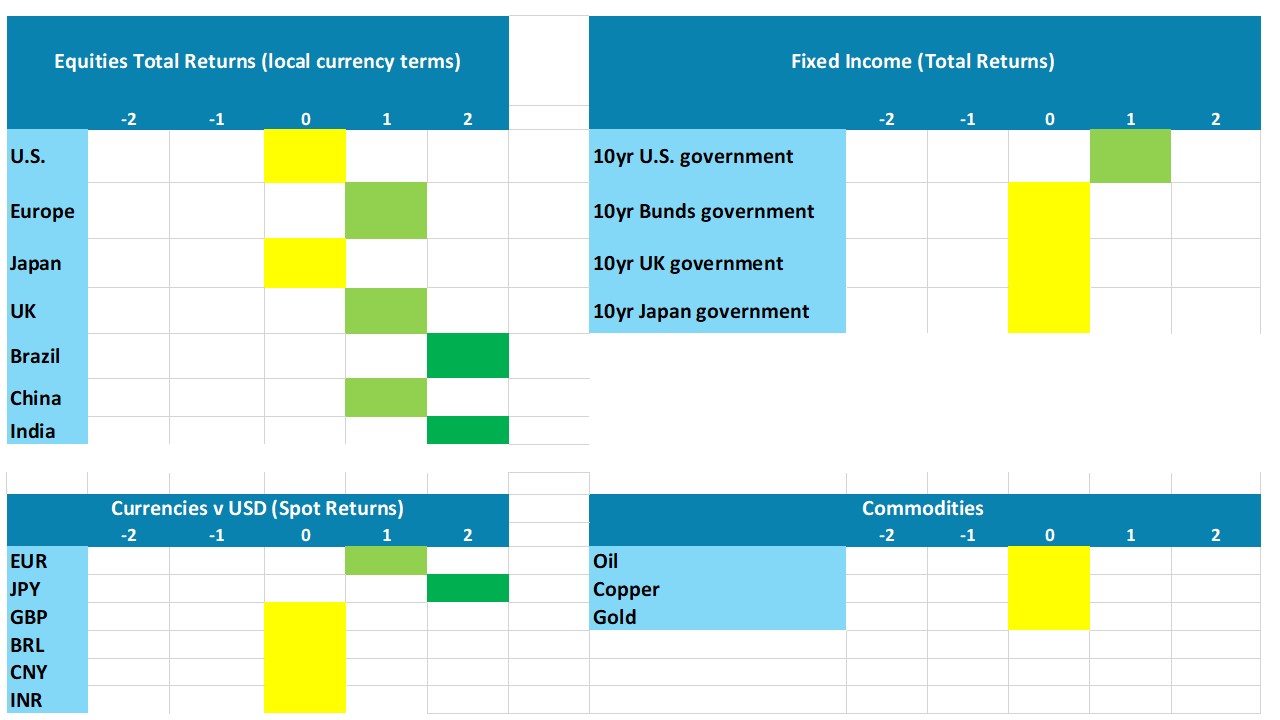Outlook Overview: Europe in Focus, Then Elections Around the World
- DM economies have avoided hard landing into 2024, as central bank tightening has not caused a sustained major hit to economies. The noticeable fall in inflation has also meant that consumers are no longer facing large real wage cuts. H2 2023 looks like a mid-cycle stagnation/technical recession in Europe, with lower gas and utility prices helping to cushion incomes. Nevertheless, the lagged impact of central bank tightening will still feedthrough to slow the U.S. economy resilience (close to 1% in H2 2024) and also mean a weak recovery in European economies (we look for +0.3% EZ GDP growth in 2024).
· Central banks in Europe will likely be the first to cut policy rates, most likely led by the ECB in June. Easing cycles will be gradual but persistent, as inflation moving back towards target produces a desire to reduce the scale of restrictive policy. This will dominated in H2 2024 and H1 2025, but debate will start in H2 2025 over where the terminal policy rate will be. If 2023 was a mid-cycle slowdown globally, structural factors will start to impact policy. Tightness in the U.S. labor market will mean that this is more of an issue for the Fed than the ECB. We see a terminal Fed policy rate of 3%. BOJ withdrawal from ultra-easy policy will be slow and modest, as Japan’s CPI inflation surprises on the downside – just likely other DM economies that reopened before Japan.
· Meanwhile, divergence remains the theme in EM. China real and nominal GDP growth will be restrained by the drag from the residential property sector; export growth being hurt by some supply chains shifting out of China and less pro-business government meaning less private sector employment/income growth. We see 4.4% and 4.0% GDP growth in 2024 and 2025. India GDP prospects are revised up helped by the demographic dividend and government investment, while PM Modi will likely be reelected and recommit to the reform agenda. However, India size is insufficient to make up for China economic weakness, while Brazil and S Africa are unlikely to break out from low to modest growth rates.
· EM elections will also be in focus, with a coalition likely after the May election in S Africa and this is likely to struggle with structural issues that the country faces. Mexico election will likely led to policy continuity, with Mexico getting some benefit from near shoring of production away from China and the prospect of 2.2% GDP growth in 2024. Meanwhile, the election of a pro-China speaker to the Taiwan parliament likely means that China will not escalate tensions too far with Taiwan and fears of a war in the next few years are overdone.
· However, the biggest election will be in the U.S., where the presidential race looks to be 50/50 between Joe Biden and Donald Trump. A reelected Biden would likely mean policy continuity with a divided Congress. If Donald Trump were elected it would likely mean a new trade war with China and less support for Ukraine that could cause a Russia friendly ceasefire in the war – Europe would be outraged and likely stop a peace deal. The UK will also likely hold a general election in October and a new Labour government will likely follow a similar budget deficit trajectory as the Conservatives, but the market will hope that it lead to a better trade deal with the EU.
· Structural forces are also a consideration. Mega tech AI investment is boosting U.S. investment, but the economic benefits of AI to productivity and wider growth will come in the 2 half of the decade. Fragmentation of globalization threatens higher prices long-term, but in 2024 and 2025 excess production means steady to fall export prices in China. The energy transition also threatens higher inflation long-term, but new LNG exports from Qatar and U.S. in 2025 will likely cap gas and utility prices.
Risks to our views: DM countries could see stronger lagged effects on the economy from the 2022-23 monetary tightening that could prolong the EZ/UK recession or move the U.S. slowdown towards a mild recession. Separately, in China the impact of the residential construction decline could be stronger than expected in economic and financial instability terms and cause noticeable downside risks to our baseline China forecast. This may negatively affect EM economies (Figure 1).
Figure 1: Economic Scenarios

Source: Continuum Economics
Figure 2: Change in Key Policy Rate and 10yr Government Bond Yield Since 31 Dec 2022 (%)
Source: Continuum Economics (Updated March 22)
Market Implications
Figure 3: Asset Allocation for the next 9 Months
Source: Continuum Economics Note: Asset views in absolute total returns from levels on March 22 2024 (e.g., 0 = -5 to +5%, +1 = 5-10%, +2 = 10% plus).
· Government Bonds. 2yr U.S. Treasury yields will likely fall consistently as the Fed starts easing from H2 2024. However, 10yr yields will likely rotate around 4%, with the debt ceiling likely to cause a temporary modest spike in 10yr yields in H1 2025. EZ and UK will also see a process of less inversion of government bond yield curves giving way to positive shaped yield curves.
· Equities. U.S. equities are overvalued and can push on only for further modest gains. The market is also vulnerable to either slower growth or stubborn inflation. UK equities can outperform on hopes that a new Labour government can get a better trade deal with the EU. In EM, India equities are preferred structurally on persistent high corporate earnings growth, though China can see a further tactical bounce.
· FX. The USD is clearly overvalued against DM currencies and will likely decline modestly once the Fed starts easing policy, as the absolute level is as important as yield spreads. EM FX outlook is dominated by domestic fundamentals and we see China accepting some controlled exchange rate adjustment.
· Commodities. Oil prices will likely remain choppy around current levels, as any boost to oil demand on economic recovery will likely be meet by less production cuts from OPEC+. Gold prices should rise further as central banks (including China) significantly increase gold holdings.
Figure 4: Key Events
| April to May 2024 | India Elections | Given the ruling Bhartiya Janta Party’s recent victories in key Indian states, it appears that the up-coming national elections will see another Narendra Modi wave. Mr Modi remains the top candidate for the position of prime minister, and will likely secure a majority in the upcoming 2024 national elections. Opposition alliance is only likely to dent the majority margin, albeit only marginally.
|
| May 2, 2024 | UK Local Elections (Possible General Election) | Local Council are up for re-election in many parts of England, with the ruling Conservative government having to defend major gains when they were last held back in 2021. This would be the last election before a general election that has to be held by January 2025, but if there is a giveaway Budget in March, the government could call an early general election to be held alongside these local ones. |
| May to August 2024 | S Africa Election | General elections in South Africa is due in 2024. We think ANC is at risk of losing its majority as ANC’s popularity is in decline due to power cuts, unemployment, inequality, the rising cost of living, and corruption. Democratic Alliance, the second largest party, together with the Inkatha Freedom Party and other smaller parties initiated the Multi-Party Charter for South Africa to unite opposition, but left Economic Freedom Fighters outside, which is the third largest party. According to recent polls, a coalition government at national level seems probable, for the first time in country’s history, as support to the ANC is below 50% according to most of the pools. We think a clear ANC victory would be a positive surprise if Ramaphosa remained president, but the election outcome is close to call this far out. |
| June 6-9, 2024 | European Parliamentary Elections | MEPs have recently vote to increase EU Parliament size as a disagreement with national ministers continues. MEPs on the aim one year ahead of the election is create 11 extra seats in the European Parliament while also saving 28 for the potential creation of a transnational constituency. Given recent national election results and polls, the performance of right-wing Eurosceptics will be the most scrutinized. |
| July 2024 | Mexico General Election | Mexicans are going to elect the President to serve a six-year term, bear in mind that incumbent President Manuel Lopez-Obrador is not going to be a candidate as Mexican Constitution vetoes re-election. Additionally, 128 members of the Senate will be elected for a 6-year term and 500 members of the Chamber of Deputies for a 3-year term. Lopez-Obrador Party, MORENA, is likely to win the Presidential election and hold the majority of the two chamber, but a 2/3 control, which would allow MORENA to pass legislation by itself, is an unlikely scenario as the traditional parties PRI and PAN will also hold a significant number of seats. |
| October 2024 | Brazil Municipal Elections | All Brazilian municipalities will hold elections to decide the mayor of the municipality and the members of the local assemblies. |
| November 5, 2024 | U.S. Elections | For President, another contest between President Joe Biden and former President Donald Trump looks increasingly likely. It will be close though we still lean to a win for Biden. Trump’s current lead in the polls largely reflects views on Biden. Come the election, negativity towards Trump may outweigh negativity towards Biden. The contests for Congress will also be close. Republicans look likely to regain control of the Senate, where the Democrats are defending more vulnerable seats, but dysfunctional Republican leadership in the House gives the Democrats a good chance of regaining control there. |
Source: Continuum Economics

